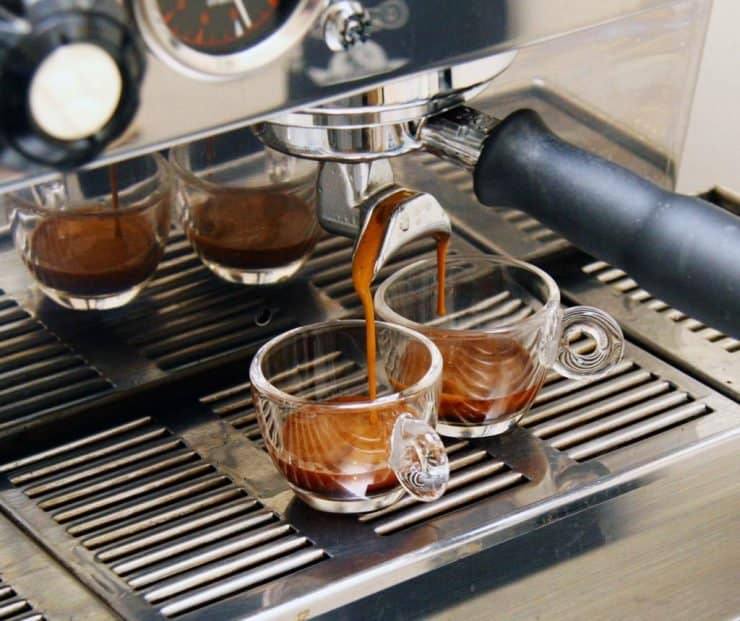The Ultimate Contrast of Popular Coffee Brewing Methods for Home Baristas
Wiki Article
The Science Behind Coffee Developing: Just How Temperature and Time Affect Your Beverage
Understanding the scientific research behind coffee brewing discloses that temperature level and time are not mere variables however critical elements that determine the beverage's flavor account and overall top quality. As we check out the subtleties of these aspects, the question develops: just how can one efficiently equilibrium temperature and time to attain that ideal mixture?The Chemistry of Coffee Extraction
The chemistry of coffee removal digs right into the elaborate processes that change raw coffee beans right into the aromatic drink taken pleasure in worldwide. This change primarily involves the solubility of different substances existing in the beans, which are affected by elements such as work size, water top quality, and the brewing method utilized.Throughout the brewing process, warm water acts as a solvent, extracting soluble compounds, including caffeine, sugars, acids, and lipids, from the coffee premises. Each compound adds to the taste profile, scent, and body of the final drink. Acids are liable for tangy and bright notes, while oils add to an abundant mouthfeel.
The removal procedure is not uniform; different compounds dissolve at various prices. The first phases of developing remove acids and sugars, resulting in a pleasurable level of acidity, while long term removal can bring about bitterness because of over-extraction of unwanted substances. Recognizing these chemical communications is crucial for maximizing brewing techniques, as the balance in between removal time and water temperature level can considerably affect the general high quality of the coffee. Eventually, grasping the chemistry of coffee extraction is vital to achieving a all-around and flavorful mug.
Suitable Brewing Temperatures
Locating the right developing temperature is important for unlocking the complete capacity of coffee tastes and scents - coffee brewing methods. Research study indicates that the optimum variety for developing coffee exists between 195 ° F to 205 ° F(90 ° C to 96 ° C) Within this array, the extraction procedure successfully dissolves the preferable soluble compounds in coffee beans, leading to a well balanced and delicious cupDeveloping at lower temperature levels, such as below 195 ° F(90 ° C ), might result in under-extraction, generating a weak and acidic mixture with muted tastes. Conversely, developing at temperature levels surpassing 205 ° F(96 ° C) can result in over-extraction, generating a bitter and extreme preference due to the extreme dissolution of undesirable substances, such as tannins.
Moreover, the suitable brewing temperature can differ depending on the coffee bean kind and roast degree. Lighter roasts typically profit from slightly greater temperature levels to improve their complex taste profiles, while darker roasts might be better fit to reduced temperature levels to reduce resentment.
Ultimately, preserving precision in brewing temperatures is critical for achieving a harmonious balance of flavors, ensuring that every cup of coffee delivers a gratifying sensory experience.
Effect of Developing Time
Brewing time plays a crucial function in identifying the flavor account and general quality of coffee. Much shorter brewing times can result in under-extraction, leading to a weak or sour taste, as not enough soluble substances are liquified.Optimal developing time varies read more relying on the approach used and the work size of the coffee. For example, a French press typically needs concerning four mins, while coffee extraction is usually completed within 25 to 30 secs. It is crucial to calibrate brewing time in combination with other variables, such as water temperature level and coffee-to-water proportion, to achieve the preferred taste profile.
Recognizing the impact of developing time enables coffee lovers to improve their brewing strategies, ultimately improving the sensory experience of their cup (coffee brewing methods). With cautious focus to this variable, one can unlock the complete possibility of the coffee, exposing its unique attributes and nuances
Brewing Techniques and Their Results

As an example, approaches like French press and cool mixture enable a much longer steeping time, leading to a fuller body and robust flavor due to enhanced extraction of oils and soluble solids. On the other hand, espresso developing uses high pressure and a shorter extraction time, producing a concentrated shot that stresses extreme tastes and an abundant crema.
Pour-over strategies, such as Chemex or V60, use an even more controlled extraction procedure, permitting the maker to control flow price and water circulation, which can boost brightness and clarity. Meanwhile, percolation approaches cycle water via the coffee premises several times, leading to a stronger, frequently bitter flavor.
Finally, making use of paper filters versus steel filters can additionally affect the last preference; paper filters generally generate a cleaner mug by trapping oils and great bits, while metal filters permit even more oils to go through, adding to a fuller mouthfeel - coffee brewing methods. Recognizing these nuances can elevate the coffee experience significantly
Tips for Developing Your Brew
A well-executed brew can change even the most basic coffee right into an impressive experience. Grind the beans just prior to making to take full advantage of quality, guaranteeing the work dimension matches your brewing technique-- coarser for French press and finer for coffee.Water high quality plays a crucial function; usage filtered water complimentary from impurities. The optimal developing temperature ranges between 195 ° F and 205 ° F(90 ° C to 96 ° C ) Too warm can blister the coffee, while also amazing might under-extract flavors.
Timing is equally essential. For immersion techniques, soaking for 3 to five mins is optimum, whereas drip methods normally take about five minutes. Explore mixture times to locate your preferred strength.

Final Thought
In recap, the complex partnership in between temperature level and time is vital in the coffee developing procedure. Adhering to optimal developing temperatures between 195 ° F and 205 ° F, alongside exact timing customized to each technique, ensures the desired taste account is attained. Recognizing these clinical principles equips people to fine-tune their brewing techniques, ultimately bring about an extra enjoyable and well balanced coffee experience. Proficiency of useful reference these aspects is necessary for any type of coffee lover seeking excellence in their drink.Comprehending the scientific research behind coffee developing exposes that temperature and time are not simple variables however crucial elements that determine the beverage's taste profile and total top quality. Comprehending these chemical communications is critical for enhancing developing strategies, as the equilibrium between removal time and water temperature level can significantly influence the total high quality of the coffee.Developing time plays a pivotal role in determining the flavor account and overall try here high quality of coffee. By concentrating on these elements-- bean high quality, grind dimension, water temperature, soaking time, and proportion-- you can boost your coffee developing process, resulting in a continually premium mug.
In recap, the elaborate partnership between temperature level and time is vital in the coffee developing process.
Report this wiki page